As a rule, it’s a last resort to talk about the weather, but Sturla Gunnarsson thinks it’s very interesting. The Emmy- and Genie award-winning filmmaker has revelled in extreme climates since his childhood in Iceland and says that he’s at his happiest when contending with the elements. “I like weather,” says Gunnarsson over lunch in downtown Toronto. “My comfort zone is just not in a moderate place. I like it to be really cold, really hot, really rainy or really windy. There’s no such thing as bad weather. There are only bad clothes.”
So you won’t get any sob stories about a film crew getting soaked in this story about Monsoon, a majestic new documentary shot on location in India and beneath torrents of relentless rain. (The film will touch down this fall at the Toronto International Film Festival.) If Gunnarsson’s previous David Suzuki doc, Force of Nature, was a wary meditation on climate change, Monsoon is an awestruck homage to a meteorological force that has continued unabated for thousands of years. “I think that Monsoon has a pagan soul in the same way that Force of Nature does,” says Gunnarsson. “It speaks to the same idea that Suzuki has about the ‘invisible tendrils of attraction,’ which is what some people call love. There is that same sense of intuition, and of something numinous within nature.”
Certainly some of the imagery in Monsoon touches on the supernatural: the repeated images of gathering clouds and drenched land- and cityscapes have an eerie beauty pitched somewhere between ancient paintings and CGI. “I wanted to do something really cinematic and which would play on a big screen,” explains Gunnarsson, who shot Monsoon using high-definition 4K Red Epic cameras—the same ones used for some sequences in Jennifer Baichwal and Edward Burtynsky’s similarly stunning Watermark. He says that what he was after in Monsoon was a combination of epic scale and intimacy, and that he wasn’t about to sacrifice one for the other. Still, the most lingering images in the film are those that go big, and he’s proud of them. “There is a shot near the end that overlooks the Bangladesh flood plains, and you’re talking about thousands of kilometres [inside the frame]. You can see the curvature of the Earth.”
Monsoon took shape after a meeting between Gunnarsson and producer Ina Fichman, who pitched him the project shortly after the release of Force of Nature. But it wasn’t the first time that the director had considered making a movie on the topic. “I’d been thinking about it for a really long time, probably since I first heard the word ‘monsoon,’ which was just so romantic,” he says. “When I made Such a Long Journey, I was [in India] just before the monsoon arrived. It was so trippy and druggy and interesting that it just got into my head.”
Although it’s a Canadian-French co-production directed by an Icelandic filmmaker, Monsoon doesn’t feel like the work of outsiders. Starting with the shoot for Such a Long Journey, his award-winning adaptation of Rohinton Mistry’s Mumbai-based character drama, Gunnarsson is very familiar with India. “For whatever reason, I’m very comfortable there,” he says. “I have photos from the set when I was directing Such a Long Journey, and while that was a very challenging production, I have this big shit-eating grin on my face in every single one. It’s not an easy place to get things done: Sometimes, it’s like you can just do one task a day. In Bombay, you just try to drive to town and that’s it for the day. In India, the three things you need to drive are good brakes, a good horn and good luck. But there is also something that transcends all that, and you just let things go.”
That’s a healthy philosophy for a film shoot that was designed to be at the mercy of the weather. Where other film shoots might try to shoot around rainfall, Gunnarsson was tracking overcast skies with the relentlessness of a bounty hunter. “It was just so capricious,” he says. “You have a crew and the meter is running. There’s only so much money and so much time. You’re reading the reports and saying ‘It should be raining here now, but it isn’t.’ You wonder if you should get on a plane and go to the next place. Or you get to the next place and the rain has stopped. Every night, we’d go to bed studying satellite images. And so we were like everyone else in India during monsoon season. We’re subject to the rain gods.”
This feeling of deference to the elements is a major theme in Monsoon, which focusses on a wide cross-section of human characters to complement its ephemeral, eponymous subject. The first character we meet is Akhila Prasad, a 12-year-old girl living with her family by the riverside in Kerala; they’re well accustomed to the effect that the monsoon will have on their immediate surroundings, but the film makes it clear that their preparations before the start of the rainy season are at best provisional. But then the same goes for Mr. Santosh, the director of an observatory dedicated to tracking the monsoon and predicting its severity from year to year. And then there is Bishnu Shastri, a Calcutta bookie who takes bets (and occasionally, a bath) on where the rain is going to start or stop next.
Gunnarsson carefully handpicked his cast one year before rolling cameras during a visit to India with his son. “Over the course of two weeks, we travelled the whole route,” he says. “I looked at the path of the monsoon and at the places where it was going to have the most dramatic impact, like the backwaters and the locations below sea level. And in Bombay, of course. The arrival of the monsoon in Bombay is always a mythological thing. We were looking for people whose lives would intersect with the monsoon in some way.”
One of the most interesting things about Monsoon is that while the people onscreen are charming, they’re also oddly passive; even the ones with big personalities, like the Calcutta bookie, radiate—but with ambivalence. Gunnarsson says that this shared sensation of being acted-upon is the access point to a larger philosophical truth. “I’ve been to places where the weather is big, like Iceland. But the monsoon is something that happens every year, since the beginning of time. There are stalactites in caves that can tell you how big the monsoons were thousands and thousands of years ago. You still don’t know, though, how big it will be. Or where it’s going to move. That defines the fatalism that you feel in India, I think. One year, a farmer will get all the rain he needs for his crops and thirty kilometres away, another guy will get nothing. And then the next year, it’s totally reversed. The monsoon defines the conditions of existence in India.”
It also defines many aspects of the culture, and while Monsoon is first and foremost a piece of reportage—it begins before the rainfall and continues on to its end—it has its reflective aspects as well.…
To read more about the making of Monsoon, purchase a copy of POV’s Fall 2014 issue at the TIFF Bell Lightbox Store, online, or subscribe to get it as your first issue!












